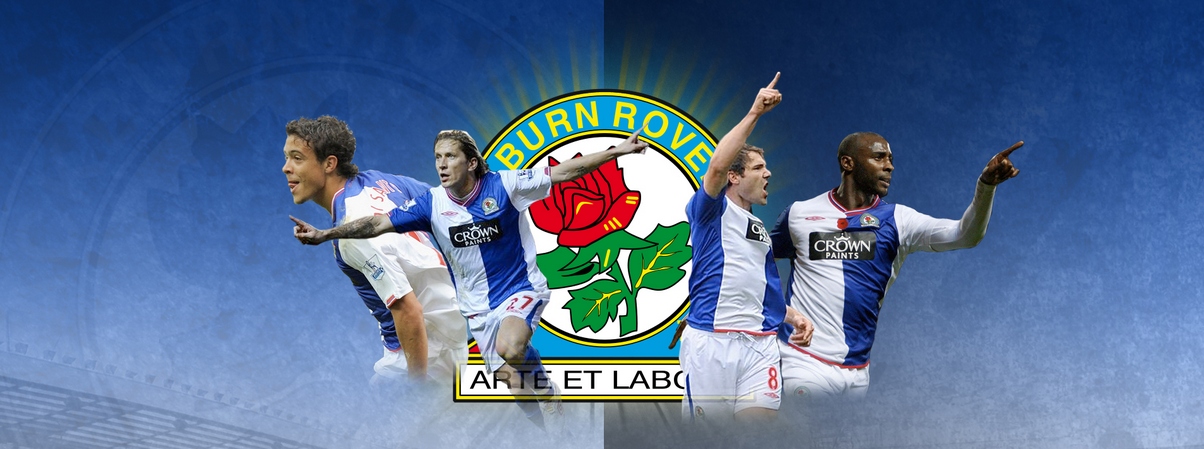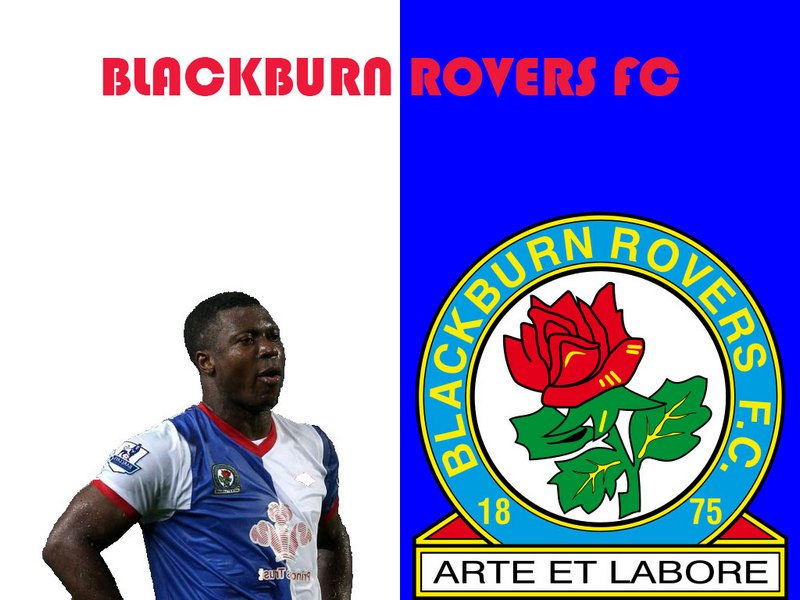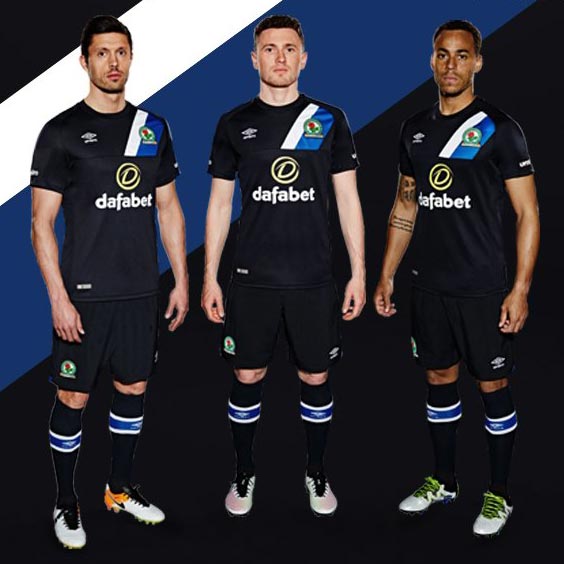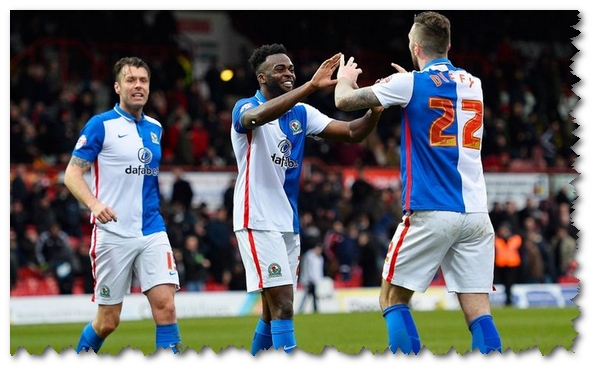
Blackburn Rovers FC is a professional association football club in Blackburn, Lancashire, England, which has competed in the Championship since relegation from the Premier League at the end of the 2011–12 season. The club was established in 1875, becoming a founding member of The Football League in 1888. It is one of only three clubs to have been both a founder member of the Football League and the Premier League (the others being Aston Villa and Everton). In 1890, Rovers moved to Ewood Park. Blackburn Rovers have been English champions three times, and have won six FA Cups and one Football League Cup. Blackburn are the only extant club to have won three consecutive FA Cups. The club has spent the majority of its existence in the top flight of English football (72 years).
In 1992, Rovers gained promotion to the new Premier League a year after being taken over by local entrepreneur Jack Walker, who installed Kenny Dalglish as manager. In 1995, Rovers became Premier League champions.In the 1998–99 season, the club was relegated. It was promoted back to the Premier League two years later, in the 2000–01 season. It has qualified for the UEFA Cup four times: once as League Cup winners, twice as the Premier League's sixth-placed team and once via the Intertoto Cup. The 2011–12 season marked the club's 72nd, non-consecutive, year in the top flight. Rovers are currently one of only six clubs to have won the Premier League, along with Arsenal, Chelsea, Manchester United, Manchester City and Leicester City.
The club was founded following a meeting, at the Leger Hotel, Blackburn, on 5 November 1875. The meeting was organised by two young men, namely John Lewis and Arthur Constantine. The purpose of the meeting was "to discuss the possibility of forming a football club to play under Association rules". The first match played by Blackburn Rovers took place in Church, Lancashire on 18 December 1875 and was a 1–1 draw.
On 28 September 1878, Blackburn Rovers became one of 23 clubs to form the Lancashire Football Association. On 1 November 1879 the club played in the F.A. Cup for the first time, beating the Tyne Association Football Club 5–1. Rovers were eventually put out of the competition in the third round after suffering a heavy 6–0 defeat by Nottingham Forest.On 25 March 1882 the club won through to the final of the F.A. Cup against the Old Etonians. Blackburn Rovers was the first provincial team to reach the final, but the result was a 1–0 defeat by the Old Etonians.
Rovers finally won the F.A. Cup on 29 March 1884 with a 2–1 victory over the Scottish team Queen's Park. The same teams played the F.A. Cup final again the next season, with Blackburn Rovers again emerging victorious, with a 2–0 score. Rovers repeated this success yet again the next season, winning the final replay 2–0 against West Bromwich Albion. For this three-in-a-row of F.A. Cup victories, the club was awarded a specially commissioned silver shield.The 1885–86 season was the birth of the legal professional footballer, and Blackburn Rovers spent £615 on player wages for the season.
Blackburn Rovers were founder members of the Football League in 1888.Blackburn Rovers again reached the F.A. Cup final on 29 March 1890 at the Kennington Oval. The club claimed the trophy for the fourth time, by beating Sheffield Wednesday a hefty 6–1 with left forward William Townley scoring three goals and becoming the first player to achieve a hat-trick in the F.A. Cup final.
The 1890–91 season saw Blackburn Rovers win the F.A. Cup for the fifth time against Notts County with a 3–1 victory. During the 1897–98 season the club stayed in the first division only as the result of a decision to increase the number of teams from 16 to 18. The season did, however, mark the beginning of Bob Crompton's 45-year association with the club, both as a player and eventually as an F.A. Cup winning manager.
Blackburn Rovers continued to struggle during the early years of the 20th century, but the results began a gradual improvement. Major renovations were made to Ewood Park: in 1905 the Darwen End was covered at a cost of £1680 and the new Nuttall Stand was opened on New Year's Day 1907. During the first three decades of the 20th century, Blackburn Rovers were still considered a top side in the English league. They were First Division champions in 1911–12 and 1913–14, and F.A Cup winners in 1927–28 with a 3–1 victory against Huddersfield Town, but the F.A Cup win was their last major trophy for nearly 70 years.
Blackburn Rovers maintained a respectable mid-table position in the First Division until they were finally relegated (along with Aston Villa) from the top flight (for the first time since the foundation of the league) in the 1935–36 season.When the league resumed after the war, Blackburn Rovers were relegated in their second season (1947–48). At this time the tradition of burying a coffin began. The club remained in the second division for the following ten years. After promotion in 1958, they again returned to the mid-table position they had occupied in the earlier part of the century. During this time, they seldom made a serious challenge for a major trophy – although they did reach the 1960 FA Cup final when managed by Scot Dally Duncan. Rovers lost this game 3–0 to Wolverhampton Wanderers after playing most of the game with only 10 men on the field following an injury to Dave Whelan, who broke a leg.
There were brief hopes of a return to glory in the 1963–64 season, when a remarkable 8–2 away win over West Ham United in east London on Boxing Day took them to the top of the league. However, their lead of the league was short lived and they finished the season some way down the table as the title was seized by a Liverpool side who would record a further 12 league titles over the next 26 years, while Blackburn's fortunes took a very different route. They were again relegated from the First Division in 1966 and began a 26-year exile from the top division.

1970
During the 1970s, Blackburn Rovers bounced between the Second and Third Divisions, winning the Third Division title in 1975, but never mounted a challenge for promotion to the First Division despite the efforts of successive managers to put the club back on track, and fell back into the Third Division in 1979. They went up as runners up in the Third Division in 1980 and have remained in the upper two tiers of the English league ever since. A second successive promotion was nearly achieved the following year, but the club missed out on goal difference, and promotion-winning manager Howard Kendall moved to Everton that summer. Kendall's successor, Bobby Saxton only managed mid-table finishes for the next three seasons, then nearly achieved promotion in the 1984–85 season, but a poor finish the following year (just one place above relegation) followed by an abysmal start to the 1986–87 season cost Saxton his job.
Saxton was replaced by Don Mackay, who steered them to a decent finish that season and also victory in the Full Members Cup. In the following three seasons Mackay re-established Rovers as promotion contenders, but they fell just short of promotion each time; the closest they came was in 1988–89 reached the Second Division play-off final in its last-ever season of the home-away two-legged format – but lost to Crystal Palace. A defeat in the 1989–90 Second Division playoff semi-finals brought more frustration to Ewood Park, but the following season saw the club taken over by local steelworks owner and lifelong supporter Jack Walker (1929–2000).
1990
Following the Walker takeover Rovers finished 19th in the Second Division at the end of the 1990–91 season, but the new owner had made millions of pounds available to spend on new players and appointed Kenny Dalglish as manager in October 1991. Rovers secured promotion to the new FA Premier League at the end of 1991–92 season as play-off winners, ending 26 years outside the top flight.
Rovers made headlines in the summer of 1992 by paying an English record fee of £3.5million for the 22-year-old Southampton and England centre forward Alan Shearer. After finishing fourth in 1992–93 and runners-up in 1993–94, they went on to win the Premier League title in 1994–95. The title chase went down to the last game of the season, but despite Rovers losing to Liverpool they edged out rivals Manchester United to win the championship.
Kenny Dalglish moved upstairs to the position of Director of Football at the end of the Premier League winning season, and handed over the reins to his assistant Ray Harford.Blackburn Rovers made a poor start to the 1995–96 season, and found themselves in the bottom half for most of the first half of the season. Rovers also struggled in the Champions League and finished bottom of their group with just four points.A terrible start to the 1996–97 Premier League campaign saw Harford resign in late October with the club bottom of the division, having failed to win any of their first ten games. Relegation looked a real possibility, just two seasons after winning the league.
After an abortive attempt to bring in Sven-Göran Eriksson as manager, long-serving coach Tony Parkes took over as manager for the rest of the campaign, narrowly steering the side to survival. That summer, the manager's job was taken by Roy Hodgson, who joined the club from Internazionale. UEFA Cup football was secured with a 6th-place finish. However, Rovers made a poor start to the 1998–99 campaign and Hodgson was sacked in December less than an hour after a 2–0 home defeat to bottom side Southampton, a result that locked Rovers in the relegation zone. He was replaced as manager by Brian Kidd. However, he could not save them as the club slipped away, relegation was confirmed with a scoreless draw at home to Manchester United in the penultimate game of the season.

2000
In 1999–2000 Rovers began the season as promotion favourites, but with the club hovering just above the Division One relegation zone Brian Kidd was sacked in October and replaced in March by Graeme Souness.Jack Walker died just after the start of the 2000–01 season, and the club dedicated its promotion challenge in memory of their benefactor. Fittingly, they returned to the Premier League after a much improved season, finishing second behind Fulham.
In 2001–02, record signing Andy Cole was bought in for £8million, and Rovers won their first-ever League Cup by beating Tottenham Hotspur 2–1 at the Millennium Stadium in Cardiff, Cole scoring the winner in the 69th minute. The following season Rovers finished sixth to qualify for the UEFA Cup for the second season running. Souness left just after the start of 2004–05 to take charge at Newcastle, and he was replaced by Welsh national coach Mark Hughes.Hughes secured Rovers' Premier League survival for the 2004–05 season as well as an FA Cup semi-final against Arsenal, with Rovers finishing 15th once again. He led the team to sixth the following season and Rovers's third European qualification in five years.
Rovers reached the semi-final of the 2006–07 FA Cup, but lost to Chelsea in extra time, and finished that season's league in tenth, qualifying for the Intertoto Cup, which led to a short run in the 2007–08 UEFA Cup. In May 2008, Mark Hughes left Blackburn Rovers for the vacancy at Manchester City. He was replaced by Paul Ince, Ince's first job was to persuade some of the wantaway players to stay. with Archie Knox coming in as his assistant. Ince's time in charge started well, but following a run of eleven games without a win he was sacked in December 2008.Sam Allardyce was appointed as Ince's replacement and in 2009–10 he led the team to a tenth-place finish and a League Cup semi-final.

2010 onwards
In November 2010, the Indian company V H Group bought Blackburn Rovers under the name of Venky's London Limited for £23 million. The new owners immediately sacked manager Sam Allardyce and replaced him with first-team coach Steve Kean, initially on a temporary basis, but by January 2011 he had been awarded a full-time contract until June 2013.Kean's appointment was shrouded in a great deal of controversy since his agent Jerome Anderson had earlier played a major role in advising Venky's during the takeover of the club in the preceding months.
In December 2011, Blackburn Rovers posted an annual pre-tax loss of £18.6m for the year ending 30 June 2011. Despite this, the owners of Blackburn Rovers provided assurances over the continued funding of the club, even if they were relegated. On 7 May 2012, the club was relegated to the Championship after being defeated at home by Wigan Athletic at home in the penultimate game of the season, ending eleven years in the Premier League.
At the start of the 2012–2013 season, Steve Kean, the manager in charge for the previous relegation season, was given a chance by owners to win promotion and kept his job as the manager. Ultimately though, pressure from the supporters who had been calling for the managers removal for months resulted in his resignation as manager on 29 September 2012.

Unlike most teams, Blackburn Rovers have only ever had one design to their home kit. The distinctive blue and white halved jersey is widely acknowledged as the "town colour". Although the design has remained the same, the side in which the colours fall has often changed. Blue has resided on the wearers left since 1946 however prior to this regulation the blue and white often switched order almost yearly.
Blackburn Rovers' first ever kit is however indefinite. The 1905 book; Book of Football by Jonathan Russell describes Blackburn Rovers' first kit as a white jersey with Maltese Cross on the wearers left breast, Trousers and a blue and white skull cap. The Maltese Cross notorious with the public schools in which the founders of the club were educated. In contrast an account from the Blackburn Standard on 6 January 1894 accounts the first kit as navy blue and white quartered jersey (quartered accounting for the shirts four panels front and back), white knickers and navy hose. This account is much more synonymous with the kit today. Photographic evidence from 1878 shows the team in Blue and white halved (quartered) jerseys, white shorts and blue socks, complete with blue and white cap and Maltese Cross.
Through its history the club has adopted four badges as its crest; the Maltese Cross, the towns coat of arms, Lancashire Rose and the present day Blackburn Rovers Badge. From 1875–1882 The Maltese Cross was present on the club's first ever home kit and was worn by both the Shrewsbury and Malvern school teams. Two former Malvernians and two former Salopians played in that first team, so there is a clear link with these public schools.
During F.A. Cup finals it is tradition for the club to adopt the town's coat of arms as their badge. This tradition has carried through all eight F.A. Cup finals the cup has been a part of all the way to their last FA Cup final against Woverhampton Wanderers in 1960. From roughly 1882 and excluding cup finals the club did not use a badge until 1974. In this year the club opted for an embroidered Lancashire Rose with the club's initials "B.R.F.C." below. This badge lasted unchanged for 15 years until it was 1989 due to visibility issues of the dark red rose on the dark blue of the shirt.
From 1989 to the present day the current Blackburn Rovers badge has been used. It has encompassed the previous badge in a newer design for the Lancashire Red Rose. Circling the rose is the team name "Blackburn Rovers F.C." and the date in which the club was founded "1875". At the base of the badge is the club motto, "Arte Et Labore" which translated means, "by skill and by labour". This motto has been taken from the town motto which was adopted in 1852.